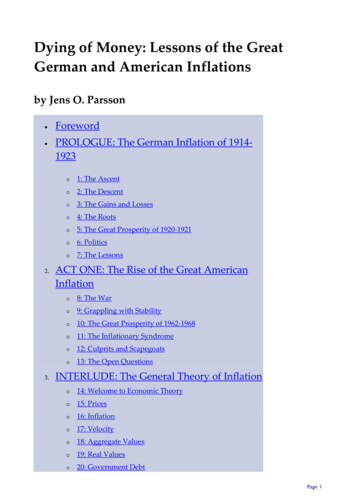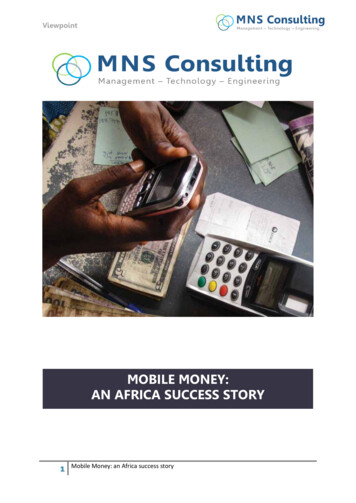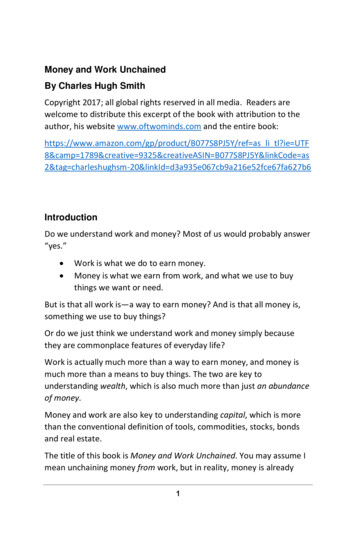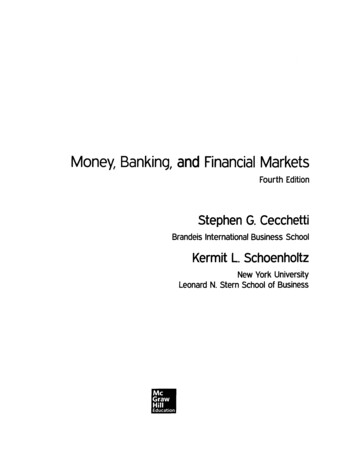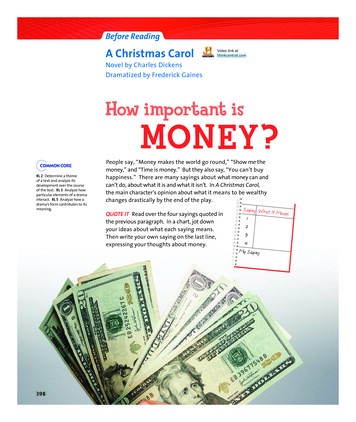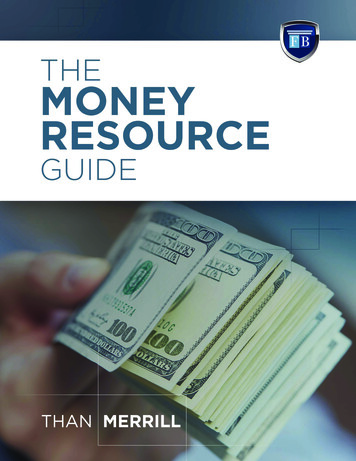
Transcription
Earnings DisclaimerAny examples depicting income or earnings are NOT to be interpreted as common, typical, expected, ornormal for an average student. Although we have numerous documented successful deals from our coachingstudents, we cannot track all of our students’ results, and therefore cannot provide a typical result. Youshould assume that the average person makes little to no money or could lose money as there is work andrisk associated with investing in real estate. The students depicted have participated in advanced FortuneBuilders’training and coaching. The participants shown are not paid for their stories; however, some of the studentsdepicted may also be a FortuneBuilders’ coach, and our coaches are compensated for their services.
IntroductionReal estate investing is one of the leading sources of wealth building. Many of the world’s millionaires madetheir money by investing in real estate – as it is one of the most lucrative investment strategies available.The most common question I hear from investors is, “How do I get money fund my next flip?” Whetheryou’re brand new to real estate investing or a seasoned pro, having financing available is extremely critical toyour success.You remember the old adage, “It takes money to make money” – well, in some cases, it’s not necessarily true.It’s a common misconception that you NEED you need tens of thousands of dollars to invest in real estate.If you’re tight on cash or have challenged credit, getting money to fund your deals isn’t a lost cause. Whatyou will need to do is educate yourself on the strategies and sources available that reduce or eliminate theamount of cash you need upfront or personal credit you need to qualify. Sometimes what it takes to makemoney, is knowing HOW to use other people’s money.When you’re first starting out, it’s about finding the money to fund you first deal. As your business continuesto grow, you’ll find you also need more than one source of capital available. Often you’ll have money tied upin one property, when you come across the deal of the century. Without alternative sources of funding, youcould lose out on some major opportunities if you’re not prepared to act quickly with an alternative source offunding.Have multiple sources of consistent financing at your disposal gives you a competitive advantage over otherinvestors as it allows you to come up with cash quickly and avoid the time-consuming bank approval processin order to purchase properties.In fact, conventional mortgage lending guidelines are much stricter these days, making it more difficult forinvestors to obtain traditional financing – often, even with large down payments.I created this guide to provide you with the key ways you can fund and acquire great deals without the useof traditional financing, often with little to no credit, or cash of your own. We use these methods everyday inour real estate business to take advantage of these goldmine opportunities – regardless of fluctuations in themortgage, housing or stock markets. Some of these financing strategies can even be combined with eachother, depending on the deal. Knowing how to creatively structure a deal will push you leaps and boundsbeyond the competition.Being unable to obtain a traditional mortgage should not hinder you from building your real estate portfolio.Keep in mind - every transaction will be different, so it’s important that you understand the many optionsavailable to you.By familiarizing yourself with the techniques outlined in this guide, you’ll be able to make well-informed,knowledgeable decisions about which financing strategy will work best for your deals.Now, let’s get started.Introduction
Table of ContentsAssignments 1Case Study of Assignment Deal 2Hard Money 3Case Study of Hard Money Deal 5Subject-To 6Case Study of Subject-To Deal 7Assumptions 8Case Study of Assumptions Deal 9Lines of Credit 10Case Study of Lines of Credit Deal 11Retirement Accounts 12Case Study of Retirement Account Deals 13Seller Finacing 15Case Study of Retirement Account Deals 16Private Money 18Case Study of Private Money Deal 20Table of Contents
AssignmentsAn assignment agreement is a contract in which one party (assignor), assigns their contractual rights toanother party (assignee). Ideally, the assignor wants the assignee to take over (and assume) all of theircontractual obligations and rights. The biggest advantage with assigning contracts is that even with little tono money, you can still make a deal happen and walk away with a nice profit.Here’s how it works. Let’s say you get a property under contract with a purchase contract. You can now buythe property and either renovate it, flip it, or keep it as a rental. But with the assignment strategy, you canalso assign the contract to someone else for a profit without doing any work to the property or buying ityourself. All contracts are assignable, unless otherwise stated in the terms of the contract. If the termsstate it is not assignable, you simply need to add the verbiage “Buyer: John Doe, and/or assigns” to makethe contract assignable.By implementing this strategy, your role is simply to find really good deals at deep discounts. You becomea valuable asset to your end buyer by locking up and controlling the contract and creating a scenario wherethey can just step in and take over your contract to acquire a great property. You’ll often find rehabberswho want to focus solely on the renovation process, seek out Wholesalers (who assign the contract), to dothe legwork of finding the property for them, and they are happy to pay for the service is return. Keep inmind, they only get the deal if you assign it to them.Assignment Pros: This is a great way to make money in real estate with little or no money out-of-pocket. You don’t have to close on the property with your own money or get a loan. You’re simply assigningyour interest in the property to someone else for a nice fee. When assigning a contract, you eliminate the need to close two transactions and incur two closingcosts. You also don’t have to pay any of the closing fees associated with a normal real estate transaction.The assignment fee agreed upon is exactly what you take home with no closing cost deductions – thismeans more money in your pocket.Assignment Cons: If you’re making a large assignment fee ( 5,000 or more), the buyer or seller could get cold feetbecause they see how much money you’re making. Some banks don’t like assignments. So if you have a buyer who’s getting financing from a traditionallender to buy your property, the assignment may create a problem and kill the deal with that buyer. It’s difficult to assign some deals such as REO’s. Bank purchase contracts sometimes will specificallydisallow it. Hard money can be an extremely viable and valuable resource for you, as some of your best deals aregoing to need funding quickly –especially if you plan to purchase more than one property at a time. Hard money lenders are organized institutional lenders who are licensed to lend money to investors/rehabbers to buy homes needing renovations.With the term “hard money,” some people can easily get confused, thinking that hard money is difficultto get – but this in fact quite the opposite. While the terms and criteria for hard money loans are relativelystrict, these types of loans can be easier to secure than most others. Hard money lenders base theirapproval on the equity in the home – not you personally.Assignments1
Assignments Case StudyMastery Student: Quincy SmithLocation: Midlothian, VAExit Strategy: Wholesaling (Assignment)Purchase Price: 60,000Holding Costs: 3,000Sale Price: 75,000How did you find and structure the deal?The seller of this property called us off one of our Probate direct mail campaigns. I sent a list of about 45probate mailings and one of the heirs of this property called me back The property was fire damaged andneeded a full gut rehab, but was located in a really nice neighborhood. The seller was a lawyer and wasreally easy to work with. He actually did a lot of the legwork with getting his sisters to sale the property. Myfirst offer was 55k, but the seller owed 58k after the insurance claim, so we agreed on 60k as a purchaseprice. Also, he was not in a great hurry so I asked for 90 days to put the deal together and he agreed.How did you finance the deal?I assigned the contract to the end buyer.How did you find a buyer for the property?Because this was my first deal and I hadn’t assembled a team yet, I didn’t think it would be best if I rehabbedthe property. I marketed the property using Open Roads, Craigslist, Backpage, and bandit signs. In theend, a Broker called me off the Zillow posting and had a rehab buyer under contract within two weeks. Ialso built a pretty good buyers list with this property by marketing it until the day it closed to my end buyer.What are some of the major lessons learned that you would like to share with other students thatthey can learn from?Never take for granted the calls that you receive from your marketing. You should have “a way” of keepingeveryone’s information that calls concerning your listings. I didn’t do a great job of this initially, but I didbuild what was the beginning of a huge buyers list from this property and also network with severalBrokers, Realtors, Loan Officers, and other Investors in the area.Any examples depicting income or earnings are NOT to be interpreted as common, typical, expected, or normal for an averagestudent. Although we have numerous documented successful deals from our coaching students, we cannot track all of our students’results, and therefore cannot provide a typical result. You should assume that the average person makes little to no money orcould lose money as there is work and risk associated with investing in real estate. The students depicted have participated inadvanced FortuneBuilders’ training and coaching. The participants shown are not paid for their stories; however, some of thestudents depicted may also be a FortuneBuilders’ coach, and our coaches are compensated for their services.Assignments Case Study2
Hard MoneyHard money can be an extremely viable and valuable resource for you, as some of your best deals aregoing to need funding quickly – especially if you plan to purchase more than one property at a time. Hardmoney lenders are organized institutional lenders who are licensed to lend money to investors/rehabbersto buy homes needing renovations.With the term “hard money,” some people can easily get confused, thinking that hardmoney is difficult to get – but this in fact quite the opposite. While the terms and criteria for hard moneyloans are relatively strict, these types of loans can be easier to secure than most others. Hard money lenders base their approval on the equity in the home – not you personally.You might find a great deal where a property is about to go into foreclosure, and you need to get the dealdone quickly. If so, run the numbers carefully for profitability after the higher loan fees and higher interestrate. Hard money lenders make their loan determinations based on the VALUE of the property in comparisonwith the purchase price, not the purchase price alone.Let me explain that further.Although all hard money lenders lend on different terms, most often hard money lenders lend around 60%to 75% of the property’s ARV. So let’s say you found a property that was worth 100,000 and had 20,000in repairs needed. You were successful at putting it under contract for 40,000. In this case, a hard moneylender would lend you up to 65,000 (65% of the property value), which would cover the purchase price ofthe house AND the renovation cost (and sometimes any other miscellaneous costs).Hard Money Pros: Most often, you can get these loans quickly – having the ability to close transactions fast. Credit worthiness isn’t necessarily a factor, as the loan is secured at a loan-to-value that covers the lenderin case of default. You can get a loan large enough to acquire and rehab the property and other miscellaneous costs.Hard Money Cons: Hard money is more expensive than many other typical sources of funding. Interest rates for hard moneyloans are significantly higher than other traditional loans in order to cover the higher risk involved. Theynormally charge 3-5 points upfront and 12% to 15% interest depending on the deal. These loans are mostly short term.With hard money, you may pay higher interest and points; but at the end of the day, if you have a greatdeal and you’re able to make a hefty profit increasing your net worth, a few extra interest points may not besuch a bad thing. Additionally, you may have an opportunity to refinance later on down the road.Hard Money3
Hard Money Case StudyMastery Students: Jeff Anderson and Joanna AndersonLocation: Richmond, VAExit Strategy: RehabPurchase Price: 80,000Repair Cost: 61,000After Repair Value: 150,000Sale Price: 215,000How did you find and structure the deal?We found the deal from a lead on Zbuyer that was listed as an inheritance. One of the strategies that I usedwas looking at the leads from the site that had comments. After finding the lead, I sent the seller a yellowletter. The seller was divorced and had really let the place go. The property was vacant, free & clear, andneeded a lot of work. The seller agreed to sell for 80,000, but went under contract for 67,000 and held a 13,000 note until we completed the rehab. The key to negotiating this deal was due to developing rapportwith the seller and being a listening ear in a time of need. His father was also dealing with sickness, so hedid not want to drag the process out any longer.How did you finance the deal?We funded the deal using a hard money lender that we met at the local REIA meeting. The lender hasbeen active in the area with many projects, and was able to offer guidance and was impressed with how wehandled this project for our first one. The terms were based on 14% and 3 points for the purchase plus rehab.Give us a short summary of how you improved the property:The house is a 3 bed 2 bath 1720 sq. ft ranch and was in really bad shape. The kitchen was outdated, therewas wood paneling, and the bathrooms were filled with mold. The layout needed to be altered to makethe former “man cave” in to a master suite with a bathroom. This was a major upgrade because it becamethe main selling feature of the home with an included fireplace. One of the bathrooms was replaced with alaundry room and a patio was added in the back. The front yard was landscaped and reseeded to removewhat was a mess of weeds and vines. The curb appeal was outstanding with the landscaping and afterresealing the driveway. The huge two-car garage was painted on the inside and the floors to give it an extraclean look.We ended up staging the property as well which was recommended by one of the coaches and this helpedmove the property in one day. I had one of my friends take professional pictures that came out excellent fornext to nothing in cost.How did you find a buyer for the property?We listed the property on the MLS at 205,000 and promoted our open house a week before we allowedanyone access. Joanna is a Realtor, so we listed it with her and also marketed on Facebook, Realeflow,and used signs. The buyer came to the open house and was prepared to make an offer that evening. AfterHard Money Case Study4
knowing that there were multiple offers, they offered the highest at 10,000 over the asking price. Afterhaving to deal with the 90 day seasoning, we were able to close in a decent amount of time to preserve agreat profit.What are some of the major lessons learned that you would like to share with other students thatthey can learn from?Having a detailed scope of work was key. We were able to reference back to it during any discrepancies.We also learned to go with your gut if you feel something is not to your liking after the final walk through.No matter how the contractor tries to sell you on how something is not a big deal, ensure that it is to yourliking. If you notice, the buyer will notice. We had to go back and fix the hardwood floors after ourwalkthrough and luckily there was a suggestion made from the buyer’s Realtor that solved the issue, andthe contractor got right in to fix it.The second lesson we learned is that staging and professional photos were also a major difference maker.We rented the furniture from Rent-A-Center and Joanna did the staging herself, and I got a friend who is afreelance photographer that just wanted to take the pictures for next to nothing. We also learned to put itout on MLS before you allow anyone to walk through to spark more anticipation for an open house.Another lesson learned was to get to know the neighbors. They were helpful with keeping us up to datewith anything they may have seen that could have been odd on the construction site, and also very thankfulfor the improvement that we did to their neighborhood.Any examples depicting income or earnings are NOT to be interpreted as common, typical, expected, or normal for an averagestudent. Although we have numerous documented successful deals from our coaching students, we cannot track all of our students’results, and therefore cannot provide a typical result. You should assume that the average person makes little to no money orcould lose money as there is work and risk associated with investing in real estate. The students depicted have participated inadvanced FortuneBuilders’ training and coaching. The participants shown are not paid for their stories; however, some of thestudents depicted may also be a FortuneBuilders’ coach, and our coaches are compensated for their services.Hard Money Case Study5
Subject ToNo-money-down strategies are a great way for new investors to get involved in real estate. While some ofthese strategies do occasionally require some capital, the amount is usually much lower than other types ofreal estate investing strategies. Subject to investing is a method for taking ownership of properties “subjectto” an existing mortgage loan that’s already in place on the property without paying off the underlying loanbalance. When we take over loans subject to the existing mortgage, the loan stays in place. The homeowneralso stays on title until we're able to refinance and pay off the entire loan, or sell it sometime in the near future.Another common question new investors always ask is, “How can someone take over an existing loan andleave it in the homeowner’s name when most mortgages today have a due on sale clause? Won’t the lendercall the loan due?” Yes, lenders certainly can call the loan due. But will they actually call the loan due?Well, it’s not very likely – as long as the mortgage is being paid. Banks are not in the business of managinghouses. They don't want houses; they want payments. As long as they have a performing asset, they are notgoing to call the loan due in order to have a non-performing asset.Usually a seller who is willing to sell their home and willing to leave their existing financing in place is distressedfor one reason or another, such as job loss or financial strain. They’re motivated to sell, have decent credit,and don't want a foreclosure or short sale effecting their credit scores. Because they’re in financial strain,they also don't want to come out-of-pocket to pay any closing costs or fees associated with selling the property.Subject To Pros: If done correctly, this strategy will allow upfront capital, monthly cash flow and equity. You’re able to acquire properties without assuming the credit risks or coming out-of-pocket with typicaldown payment amounts. Since your credit is not being used, you can purchase multiple homes with this strategy. There’s typicallyno limit to the number of houses you can own when the loans are in other people’s names. The homeowner benefits because they can sell their property without many of the fees inherent to thetraditional sales transaction, such as Realtor fees and other closing costs.Subject-To Cons This strategy requires a good amount of legal paperwork. There’s a possibility that the lender could call the loan due. You are relying on the seller to make the mortgage payment. As investors we do our best to minimizethe risk involved with any transaction. Building strong relationships and writing solid contracts are especiallyimportant with a subject to deal to ensure the seller follows through and pays the mortgage with thefunds you’re paying them.Subject To6
Subject To Case StudyMastery Student: Jason GastonLocation: Spring Hill, FLExit Strategy: RehabPurchase Price: 56,000Repair Cost: 15,500Holding Costs: 14,000Sale Price: 103,000How did you find and structure the deal?We found this deal from a seller calling one of our bandit signs. This deal was purchased subject to theexisting mortgage.How did you finance the deal?This deal was purchased subject to, so we took over the mortgage payments and put some cash in theseller’s pocket using funds from one of our private lenders at a 12% annual return.Provide a summary of the repairs and improvements you made to the property.Interior walls textured and painted. New laminate flooring in the living area and new carpet in the bedrooms.Replaced all counter tops with granite, and added new hardware for all of the cabinetry. New lightingfixtures throughout the house. New sinks and fixtures in kitchen and baths. Repainted the exterior of thehouse. New sod and landscaping. Serviced existing A/C.How did you find a buyer for the property if you sold it?The buyer was actually an agent himself. He saw the open house advertisement that we dropped off at hisreal estate agency.What are some of the major lessons learned that you would like to share with other students thatthey can learn from?I learned that you can creatively structure a deal subject to the existing mortgage, and lower your risk whileincreasing your ROI.Any examples depicting income or earnings are NOT to be interpreted as common, typical, expected, or normal for an averagestudent. Although we have numerous documented successful deals from our coaching students, we cannot track all of our students’results, and therefore cannot provide a typical result. You should assume that the average person makes little to no money orcould lose money as there is work and risk associated with investing in real estate. The students depicted have participated inadvanced FortuneBuilders’ training and coaching. The participants shown are not paid for their stories; however, some of thestudents depicted may also be a FortuneBuilders’ coach, and our coaches are compensated for their services.Subject To Case Study7
AssumptionAssumable mortgages, also called “assumable loans” are when you take over the seller’s existing mortgage.This strategy is often confused with “subject to” investing. These are two very different strategies andknowing the difference is very important.When you acquire a property subject to an existing mortgage, you are informally agreeing to make thepayments to the lender, but you do not legally assume the loan. In this case, the mortgage stays in thehomeowner’s name. However, when you assume a mortgage, you formally take over the loan and place theloan in your name.Using the assumable loan strategy often allows you to purchase a property with a very low interest ratewithout any money down. These types of properties are a great find (and many of them are becoming availableagain) because those note holders are primarily interested in receiving an income stream, and they wouldprefer not to have the mortgage paid off at once.In some cases, buying a property through a mortgage assumption may require that you go through a regularloan application process with the lender, in which credit, job history, and income will determine whether ornot you will be allowed to take over the existing mortgage. If you do qualify, the note holder will allow youto maintain the original contract terms.Many assumable mortgages don’t have strict “due on sale” clauses in them – and even if they do, contactingthat original note holder will normally get you the result you want. Some homeowners know very littleabout what terms they can offer you on an assumption, so it’s always a good idea to contact the originalnote holder.Assumption Pros: An assumable loan could provide you with an interest rate much lower than what is typically availablein the market. If the original mortgage was written when rates were lower, you’ll be able to assume thatinterest rate and save some money. You won’t have to pay a down payment. You can avoid paying for closing costs, which could be significant savings for you. Many of these types of mortgages don’t have strict “due on sale” clauses so lenders won’t call theloans due.Assumption Cons: You may have to go through a rigorous application process with the lender – including a credit checkand other requirements for approval. The loan will report on your credit just like a new loan.Assumptions8
Assumptions Case StudyMastery Student: Guy VarbleLocation: Des Moines, IAExit Strategy: Buy & HoldPurchase Price: 71,500Repair Cost: NoneHolding Cost: 3,000Sale Price: n/aHow did you find and structure the deal?A real estate agent who understands my criteria broughtthis property to me. The seller didn't want any money outof the deal but also didn't want to pay any money out-of-pocketto get it sold.How did you finance the deal?I was able to assume the existing lending structure, which were bonds issued to finance the property.Give us a short summary of how you improved the property:All three units were occupied and no repairs were immediately required.How did you find a buyer for the property if you sold it?I held onto this property as a buy and hold.What are some of the major lessons learned that you would like to share with other students thatthey can learn from?Grow your network to grow your seller funnel. Know what you're looking for and let people know what youwant and what you can do so they are clear about which opportunities to bring your way.Any examples depicting income or earnings are NOT to be interpreted as common, typical, expected, or normal for an averagestudent. Although we have numerous documented successful deals from our coaching students, we cannot track all of our students’results, and therefore cannot provide a typical result. You should assume that the average person makes little to no money orcould lose money as there is work and risk associated with investing in real estate. The students depicted have participated inadvanced FortuneBuilders’ training and coaching. The participants shown are not paid for their stories; however, some of thestudents depicted may also be a FortuneBuilders’ coach, and our coaches are compensated for their services.Assumptions Case Study9
Lines of CreditFor many real estate investing businesses, a line of credit can be a reliable option when cash flow getstight or when unexpected expenses comes up. A business line of credit is like a huge credit card. With abusiness line of credit, a bank/lender offers a flexible credit amount. A maximum amount is set, and youcan access those funds any time, on demand, when you need them. You only begin to pay interest whenyou use it. Your line of credit is reduced by what you have as outstanding loans until they’re paid off, andit bounces back up to the limit. The amount of credit allotted depends on your positive cash flow. Keep inmind, the lender can increase or decrease your limit at anytime.As it pertains to real estate investing, you know that time is of the essence when it comes to securing aproperty. Let’s say you find a property that would be a fantastic deal, but there are three other investorswho are interested in it as well. Wouldn’t it be quick and simple to just pull out your checkbook and write acheck for the purchase price without worry? That’s the benefit of having a business line of credit.One of the keys to successfully obtaining funds for your deals by way of credit lines is to access as manydifferent lenders as possible over a period of time. Establish small lines of credit with several banks in yourarea. By applying to different lenders, you will able to have access to a number of business lines of credit.However, be careful not to submit a lot of applications per lender per month; you may get denied due tothe submission of too many applications in a 30-day period. Also, make sure to always pay it back on time.Once you build up enough cash reserve, you may be able to finance your own deal and cut out the middlemanaltogether. Keep in mind – this strategy usually results in higher rates than regular real estate loan rates.Line of Credit Pros: Obtaining a line of credit gives you flexibility in your real estate business and doesn’t require you to useyour own cash. Your business can build a positive credit history as you use the line and make the payments on time. You can write checks against the line of credit at any time and for any type of business expense. Although the interest rates are higher than a traditional loan, the rates are typically lower than a businesscredit card.Line of Credit Cons: Usually requires up-front fees when opening a new line of credit. Interest needs to be paid on the money it uses from the line of credit. The interest rates are usuallyhigher than a loan. Depending on your real estate business structure, you may be personally liable to repay the debt. An institution with tight lending requirements may make approval difficult and place greater restrictionson issuing new lines of credit.Lines of Credit10
Line of Credit Case StudyMastery Student: Jason GastonLocation: Virginia Beach, VAExit Strategy: RehabPurchase Price: 69,500Repair Costs: 46,747Holding Costs: 2,284Sale Price: 165,000How did you find and structu
Real estate investing is one of the leading sources of wealth building. Many of the world’s millionaires made their money by investing in real estate – as it is o
